23 December 1914 in Russia created a squadron of aircrafts "Ilya Muromets"
Ilya Muromets (or С-22) is the common name for several series of heavy four-engine all-wood biplanes, which were produced by the famous Russian-Baltic Carriage Works. At one time, "Ilya Muromets" was able to set a number of world records, including the number of transported passengers, carrying capacity, maximum height and flight time. In total, from 1913 to 1918 years, around the 80 Ilya Muromets planes of various modifications were produced. In this case, the aircraft was originally intended to be used for civilian purposes.
The plane “Ilya Muromets” was created by the aviation department of the Russian-Baltic plant in St. Petersburg, headed the project I. I. Sikorsky, who emigrated to the USA in 1918 and became more famous in the future as an American helicopter designer. The new aircraft was a further development of the design of the Russian Knight, created in 1913 year. In the course of the work, its design was significantly reworked, without significant changes, only the overall design of the machine remained, a box of wings with engines installed in a row on the lower wing of the 4 engine. At the same time, the aircraft fuselage was completely new. As a result of processing with the same German “Argus” engines with 100 horsepower. Ilya Muromets aircraft had twice the maximum maximum altitude and payload mass.
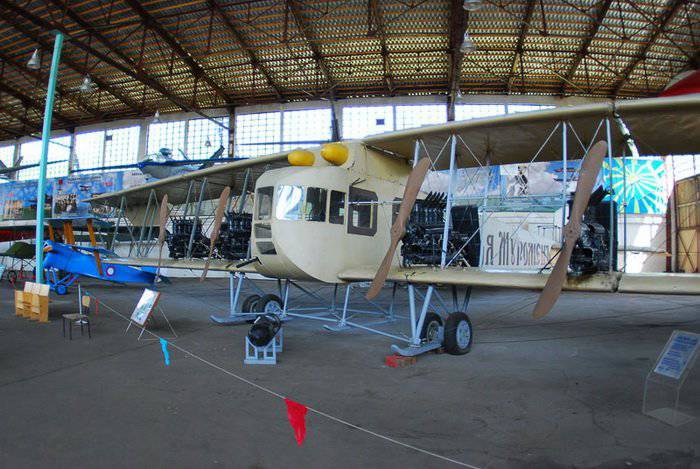
Aircraft "Ilya Muromets" became the first passenger plane in the world. For the first time in aviation history, this aircraft had a cabin separate from the cockpit, which was equipped, among other things, with electric lighting, heating (engine exhaust), bedrooms and even a bathroom with a toilet. At that time, pilots of single-engine aircraft avoided flying over cities, since in the event of engine failure, a forced landing in the city could result in a catastrophe. At the same time, the “Muromts” had an 4 engine, so its creator Sikorsky was confident in the safety of the machine.
Stopping one or even 2's from 4's engines did not mean that the plane would lose stability and would have to land. In addition, during the flight, people could walk on the wing of the aircraft, which did not disturb the equilibrium of the vehicle. During the flight, Sikorsky himself went out to the wing in order to make sure that if there was a need, one of the pilots would be able to repair the engine right in flight. At that time it was completely new and made a great impression on people.
The construction of the prototype aircraft "Ilya Muromets" at the Russian-Baltic car factory started in August 1913. The new four-engine heavy airplane was named in honor of the famous Russian epic hero. This name has become common to various modifications of the new machine. The prototype aircraft was ready by December 1913 of the year and December 10 completed its first flight. On the prototype, there was also a middle wing between the wing box and the tail assembly, and the racks of the additional middle chassis were installed under the fuselage. However, during the tests they realized that the middle wing did not justify itself, and it was dismantled. After a series of records and first successes, the military noticed the car. As a result, 12 May 1914, the Main Military Technical Directorate (GVTU) signed a contract with the plant for the construction of 10 airplanes "Ilya Muromets".
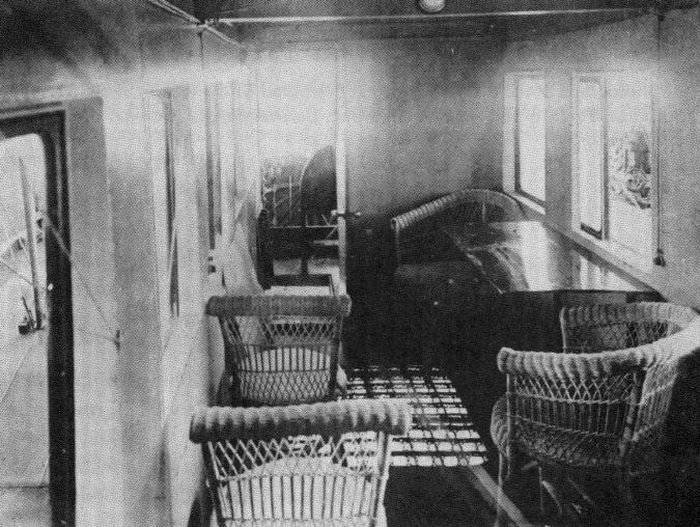
In many ways, this was facilitated by the fact that in February 1914, Sikorski raised an airplane with 16 passengers on board. At the same time, during the flight, there was another passenger on board the aircraft - the dog Shkalik, who was the favorite of the entire aerodrome. This flight was at that time an unprecedented achievement in the field of aviation. The payload during the flight over Petrograd was almost 1 300 kg. At that time, “Ilya Muromets” often flew over the capital of the empire, flying at an altitude of about 400 meters.
During the execution of these flights, passengers of the aircraft could admire the majestic boulevards and squares of the city from the height of a comfortable and closed cockpit. In addition, each flight of a four-engine airplane led to a halt of the entire ground transportation of the capital, as crowds of citizens gathered on the streets in order to take a look at the huge aircraft of that time, which emitted a strong noise of 4 with its engines.
By the spring of 1914, Sikorsky completed the construction of a second aircraft. This car was equipped with even more powerful Argus engines. Two internal had power - 140 hp, and two external - 125 hp Thus, the total power of the engines of the aircraft of the second model reached 530 hp, which is 130 hp exceeded the power of the engines of the first "Ilya Muromets". The increased power of the power plant made it possible to increase the speed and carrying capacity, and the flight altitude in 2 100 meters was reached. In its first test flight, the new aircraft lifted 6 passengers and 820 kg into the air. fuel.
By the beginning of World War I (August 1, 1914) 4 “Ilya of Muromets” were made. By September of the same year, all of them were transferred to the Imperial Air Force. fleet. By that time, all the airplanes of the warring countries were intended exclusively for reconnaissance purposes, so the Russian aircraft should be considered the world's first specialized bomber aircraft.
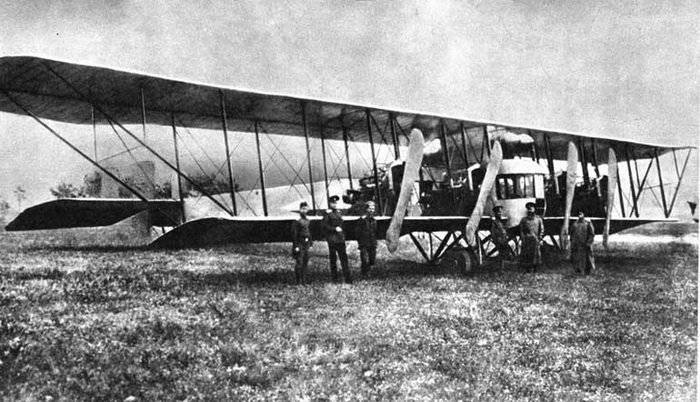
October 2 1914 was signed another contract for the construction of 32 aircraft "Ilya Muromets", the price of each machine was 150 000 rubles. Thus, the total number of aircraft ordered reached 42 units. Despite this, from the pilots who were engaged in testing the aircraft in combat conditions, began to receive negative feedback. So the captain Rudnev wrote that the Ilya Muromets planes have a low speed, do not gain enough height, are not protected, for these reasons, monitoring the fortress of Przemysl can be carried out only at the maximum possible height and long distance. At the same time, no flights to the rear and bombardments of the enemy were reported. The opinion about the new aircraft in the army was negative and the advance to the Russobalt plant in the amount of 3,6 million rubles for the construction of the aircraft of the ordered party was suspended.
The situation was saved by Mikhail Vladimirovich Shidlovskiy, who was in charge of the aviation department at Rusobalt. Shydlouski admitted that the new machine has flaws, but it pointed out that the crews of the aircraft do not have sufficient training. At the same time, he agreed to suspend the construction of a batch of 32 aircraft, but insisted that the first 10 aircraft were built in order to unite them in a squadron following the example of the navy and comprehensively test in a combat situation.
Nicholas II approved this idea and already 23 in December 1914 issued an order according to which Russian aviation was divided into light, part of military units and subordinate to Grand Prince Alexander Mikhailovich, as well as heavy, which was subordinate to the Headquarters of the High Command. The same order announced the creation of a squadron of 10 combat and 2 training aircraft "Ilya Muromets." Shidlovsky himself was appointed commander of the air squadron, who was called up for military service. At the same time, he was given the rank of Major General. So Mikhail Shidlovsky became the first aviation general in Russia. Unfortunately, in August 1918, he was shot by the Bolsheviks along with his son while trying to travel to Finland.
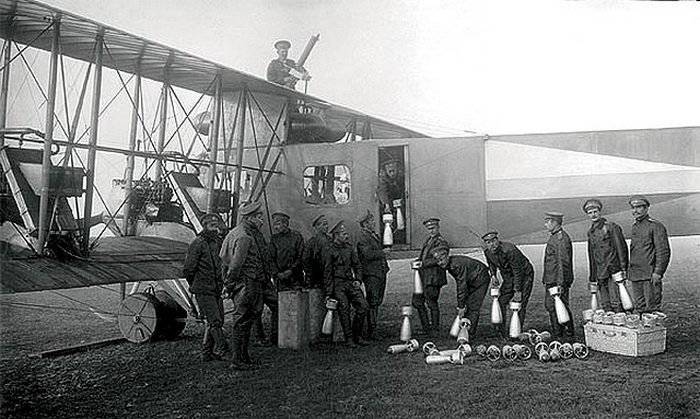
Over time, heavy aircraft began to be used as bombers, defensive weapons appeared on them, some models carried up to 7-8 machine guns. Its first combat flight in the squadron was made 21 February 1915 year. However, it ended in nothing, the pilots got lost and, not finding the target (Pillenberg), returned back. The second flight occurred the next day and became successful. The railway station was bombed and dropped a series of 5 bombs. Bombs exploded in the middle of the rolling stock, and the results of the bombing were filmed on a camera.
18 March with the help of Ilya Muromets was carried out photo reconnaissance on the route Jablonna - Willenberg - Naidenburg - Soldno - Lautenburg - Strassburg - Tori - Plotsk - Mlawa - Yablonna. As a result of this flight, it was possible to establish that the concentration of enemy troops in this area is missing. For the execution of this reconnaissance flight, the crew of the aircraft was presented for awards, and the captain Gorshkov was made a lieutenant colonel.
Thanks to the success that the squadron was able to achieve, in April 1915, the order to build 32 bombers "Ilya Muromets" was again activated. The planes were planned to be built before 1 May 1916. In 1915, the production of aircraft of the G series began, their crew was up to 7 people, some of them were equipped with a special rifle cabin. Also in 1915-1916, 3 D (DIM) series machines were released. In the fall of 1915, one of these bombers for the first time raised a bomb into the sky of an enormous mass at that time - 400 kg (25 pounds).
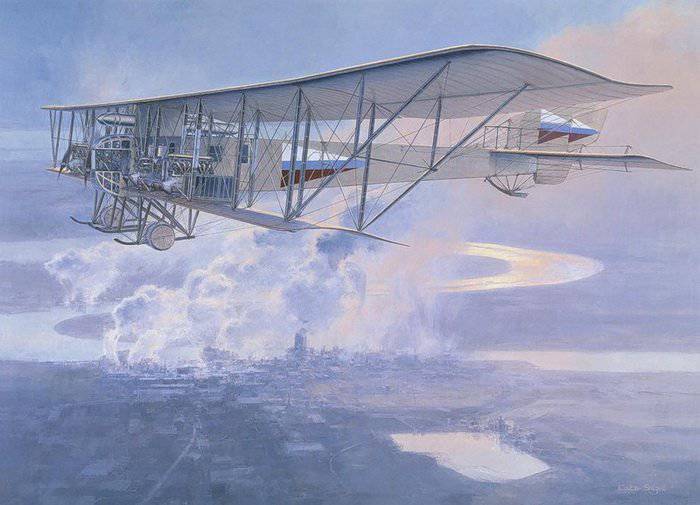
During the war from October 30 1914 of the year to May 23, 1918 of the year was lost and copied from the army of 26 aircraft of this type. At the same time, during the battles, only 4 vehicles were lost (1 was shot down by fighters, 3 by anti-aircraft fire), the remaining aircraft were lost during piloting errors, natural disasters (hurricanes, storms), and technical malfunctions.
After 1918, the Ilya Muromets planes were no longer produced, but the fleet that remained after the First World War and the Civil War was still in use for some time. For example, the first Soviet regular postal-passenger airline on the Moscow-Oryol-Kharkov route opened 1 on May 1921 of the year and worked until October 10 on 1921, during which time the 43 flight was carried out, more than 2 tons of cargo and 60 passengers were transported. However, due to the strong depreciation of the aircraft fleet, the track was eliminated. One of the remaining aircraft was transferred to the Air Shooting and Bombing School located in Serpukhov. It was used to train pilots in the 1922-1923 year, during which time the machine made about 80 flight training, but after that date the aircraft did not fly into the sky.
Performance characteristics "Ilya Muromets" version of the D-1:
Production time - 1915-1917 years
Dimensions: the span of the upper wing - 31 m. The span of the lower wing - 21 m., Length - 17,1 m.
Wing area - 148 square. m
Aircraft mass: empty - 3 800 kg., Takeoff - 5 400 kg.
Engine type - 4 inline “Sunbeam” horsepower 160. each
The maximum speed is 135 km / h.
Flight duration - 4 hours
Practical ceiling - 3 000 m.
Armament: up to 6 machine guns, 500 kg bombs.
Crew - 5-7 people.
Information sources:
-http: //www.opoccuu.com/im.htm
-http: //rufact.org/blog/2011/jul/3/the-world-and-39s-first-passenger-jet-bomber-and-a
-http: //ru.wikipedia.org
Information